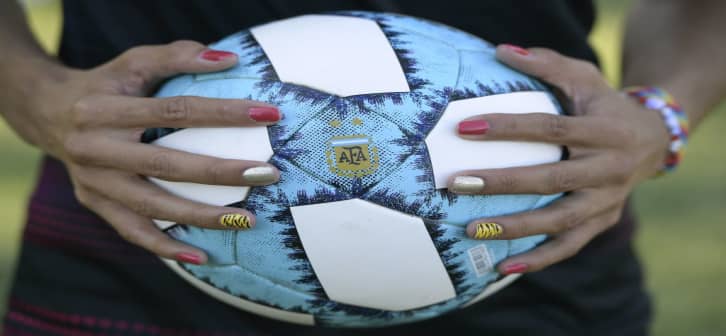How Title IX Impacts Women’s Equality in College Athletics
Writer
Writer

- Title IX banned discrimination based on sex in higher education.
- The new law increased access to women's sports at the college level.
- Since the law's implementation, women's participation in athletics has increased at all levels.
- Disparities, such as in funding and institutional support, still exist between men's and women's sports.
The first intercollegiate women's tennis tournament never happened. Faculty canceled the event in 1894 to discourage athletic competition.
Since then, women's college sports have transformed dramatically. Over 200,000 female athletes compete at the college level in basketball, soccer, volleyball, track and field, gymnastics, and tennis. After winning a gold medal in gymnastics, Sunisa Lee enrolled at Auburn University to compete as a college athlete.
A 1972 law known as Title IX helped transform women's athletics.
Today, women make up 44% of all NCAA student athletes. But that wasn't always the case. In 1971, fewer than 30,000 women played sports at the college level — representing just 15% of all student athletes. Many colleges offered few or no women's teams.
Passed in 1972, Title IX banned discrimination in higher education. The law stated that colleges could not exclude women from any activity — including sports. Suddenly, colleges that only offered men's teams found themselves out of compliance.
Title IX increased access to women's sports at the collegiate level. With the 50-year anniversary of Title IX fast approaching, a look back shows how far women's sports have come — and the fight for equality that remains.
Women's Sports Before Title IX
In 1894, two women's colleges scheduled the first intercollegiate women's sports event. The women of Bryn Mawr and Vassar would compete against each other in a tennis tournament. Until Vassar canceled the event — because the faculty refused to let students participate in extramural sports.
One student complained that the college wanted them to "run out in the garden . . . and play ball with one another nicely" rather than compete against other schools.
By the 1950s and 1960s, women athletes pushed for more opportunities. But those gains were hard-fought.
Before Title IX opened the door to greater participation in women's college sports, women athletes existed. But they typically competed against women at their own schools. Sororities hosted matches, as did intramural teams. In 1936, 70% of colleges hosted "play days" where women competed against their classmates.
Into the 20th century, most agreed that women's sports should be treated differently from men's sports. The women's division of the National Amateur Athletic Federation (NAAF) emphasized that women should "play for play's sake." The NAAF encouraged "every girl in a sport and a sport for every girl." That motto discouraged competitive spots.
By the 1950s and 1960s, women athletes pushed for more opportunities. But those gains were hard-fought. In 1957, the Division for Girls and Women in Sport amended its prior ban on intercollegiate women's athletics. And in 1963, the organization moved to encourage intercollegiate women's sports.
Title IX and College Athletics
In 1972, Title IX drastically changed the history of college athletics. By prohibiting sex discrimination by colleges, the legislation required schools to invest in women's athletic programs.
Title IX of the Education Amendments of 1972 addressed a gap in antidiscrimination legislation. The Civil Rights Act of 1964 banned colleges from discriminating against students on the basis of race, color, religion, or national origin. An amendment banned sex discrimination in employment. But until Title IX, women did not have legal protections against discrimination in higher education.
The text of Title IX stated, "No person in the United States shall, on the basis of sex, be excluded from participation in, be denied the benefits of, or be subjected to discrimination under any education program or activity receiving Federal financial assistance."
The NCAA, which dominated men's college athletics, argued that Title IX did not apply to athletic departments, because those departments did not directly receive federal funds.

Under the new law, colleges could not exclude women from certain classes or majors. They had to investigate and prevent sexual harassment on campus, which could negatively impact women's education. And every campus had to hire a Title IX coordinator to make sure the school complied with the law.
But did Title IX apply to sports?
At first, colleges debated whether the new law applied to athletics. The NCAA, which dominated men's college athletics, argued that Title IX did not apply to athletic departments, because those departments did not directly receive federal funds.
But proponents of women's sports pushed back. By the late 1970s, college athletics departments had to comply with Title IX or risk losing federal funding. As a result, colleges increased their investment in women's sports — and the number of female athletes skyrocketed.
How Title IX Transformed College Sports
The year Title IX passed, 2% of college athletic budgets went to women's sports. Around 15% of college women participated in sports. And colleges, on average, offered 2.5 women's teams.
Those numbers increased dramatically in the following decades. While fewer than 30,000 college women participated in sports in 1981, over 200,000 did in 2017. By 2004, colleges offered an average of more than eight different women's sports teams. During 2006-2016, the number of female athletes at the college level grew 25%.
The number of high school girls participating in sports grew 990% from 1971 to 2003.

After Title IX passed, colleges moved to comply with the new law. In a four-year period in the 1970s, North Carolina State increased its women's sports budget by 15 times. The University of Michigan, which had no intercollegiate teams in 1973, had 10 by the end of the decade.
The impact of Title IX spread beyond college sports. The number of high school girls participating in sports grew 990% from 1971 to 2003. Similarly, the number of female Olympians skyrocketed. In 2016 at Rio, women outnumbered men 292 to 263 on the U.S. Olympic team, compared with 90 women to 338 men in the 1972 Olympics.
Once Title IX became the law, the NCAA moved to take over women's athletics from the Association for Intercollegiate Athletics for Women (AIAW). The NCAA edged out its competition by going directly to schools and promising to pay national championship teams, waive membership fees for NCAA members who added women's programs, and guarantee television coverage for women's sports.
While the new law drastically increased opportunities for female college athletes, disparities persisted into the 21st century.
The Fight for Women's Equality in College Athletics
Title IX banned sex discrimination — but disparities still exist between men's and women's sports at the collegiate level.
A U.S. Department of Education report from 2019 found that 87% of NCAA schools "offered disproportionately higher rates of athletic opportunities to male athletes compared to their enrollment."
Pepperdine University's student-run news organization reports that female students make up 53% of the student body at Division I colleges — yet Division I athletic departments devote only 36% of their budgets to women's sports. That adds up to an extra $133 million each year for men's sports compared with women's sports at the Division I level alone.
In 1981, female coaches led 55% of women's teams; the number dropped to 40% in 2016.
Title IX does not require equal spending on men's and women's teams. Yet inequities in funding can translate to unequal treatment.
High-profile reports about disparities circulated in 2021 when athletes spoke out during the NCAA basketball tournaments. While the men's teams had a full weight room, the women received one dumbbell rack and one stationary bike. While the men dined at a full buffet, women received prepackaged food. For athletes competing at a national tournament, these differences could easily affect their performance.
Similarly, the number of female head coaches has fallen. In 1981, female coaches led 55% of women's teams; the number dropped to 40% in 2016. In addition, coaches for men's teams continue to command higher salaries.
The example of women's sports shows the impact of public policy on higher education. One law pushed colleges to invest in their women's athletics programs. But athletes, coaches, administrators, and fans need to continue to push for women's equality in college sports.
Feature Image: JUAN MABROMATA / Contributor / AFP / Getty Images
Latest News
Related Stories
Featured Stories
Latest Analysis
College Accreditation Is Changing. Here’s What Students Need To Know.

11 Red States Are Suing to Block Biden's SAVE Loan Repayment Plan. Here's What Borrowers Need to Know.

Here's Where the 2024 Presidential Candidates Stand on Higher Education

College Admissions, Student Diversity, and Campus Culture 50 Years Ago













